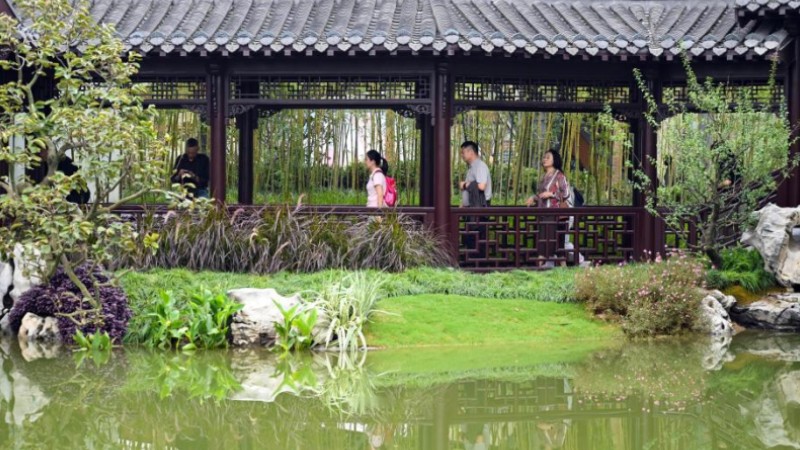FTZs advance China's high-quality development

A freight train carrying containers of durians and other tropical fruits arrives at Kunming East Railway Station in Kunming, southwest China's Yunnan Province, April 19, 2023. (Photo by Qin Wenlu/Xinhua)
BEIJING, Sept. 27 (Xinhua) -- Near a cargo terminal in Kunming, capital of southwest China's Yunnan Province, porters were busy carrying boxes of imported durians out of a cold-chain container and loading them onto a truck.
Taking only 26 hours to complete the trip from the Laotian capital Vientiane to Kunming via the China-Laos Railway, the durians grown in Thailand will then be delivered by road to Chongqing Municipality for sale.
The Kunming cargo terminal of China United International Rail Containers Co., Ltd. (CRIntermodal) is located in the China (Yunnan) Pilot Free Trade Zone (FTZ), where cargo is loaded onto and unloaded from trains using the China-Laos Railway. Since the start of this railway line's operation in December 2021, the terminal has sent more than 224,000 tonnes of cargo to Laos and received 312,600 tonnes from Laos as of Aug. 31.
"Compared with road and sea transport, rail transport is cheaper and faster, saving precious logistics time for seasonal fruits," said Xu Chao, deputy general manager of the CRIntermodal Kunming branch.

Workers unload durians and other tropical fruits in Kunming, southwest China's Yunnan Province, April 19, 2023. (Photo by Qin Wenlu/Xinhua)
Yunnan Province shares borders with Myanmar, Laos and Vietnam.
Inaugurated in 2019, the Yunnan pilot FTZ has been striving to boost connectivity between the Belt and Road and the Yangtze River Economic Belt and turn itself into an important node on the major corridor connecting South Asia and Southeast Asia.
Since the establishment of its first pilot FTZ in Shanghai in September 2013, China has established an additional 20 FTZs and also the Hainan Free Trade Port.
With different strategic positioning and development goals, the pilot FTZs distributed across the country have given full play to their own characteristics and advantages, achieving a host of achievements of institutional innovations, establishing a group of world-leading industrial clusters and making contributions to the high-quality development of the country.
A vivid example is the continuous shortening of the negative list in the Shanghai FTZ, which has given foreign investment wider market access. Since the first pilot FTZ negative list for foreign investment was implemented in 2013, also the first of its kind in China, the number of items on the list has been cut from 190 to 27 in 2021 after seven rounds of modifications.
In south China's Guangxi Zhuang Autonomous Region, a border area connecting China with the Association of Southeast Asian Nations (ASEAN) countries, the Guangxi FTZ is striving to become a new corridor for the international land-sea trade facing ASEAN countries, as well as an important gateway linking the 21st Century Maritime Silk Road and the Silk Road Economic Belt.
Liang Tong, an official with the Qinzhou Port area of the Guangxi FTZ, said the number of twenty-foot units (TEUs) handled by the port had jumped by 79.3 percent to 5.4 million in 2022 from the level in 2019. Last year, 8,820 sea-rail intermodal train trips delivered 442,000 containers, 3.9 times the figure recorded in 2019.

This aerial photo taken on Feb. 23, 2023 shows the Qinzhou Port in south China's Guangxi Zhuang Autonomous Region. (Xinhua)
Lin Jiatian, a manager with the Container Business Center of Qinzhou Area of the Sinotrans Guangxi Co., Ltd., said the logistics company used to ship goods from Chongqing to Singapore via Shanghai, which took nearly 20 days.
"With the rail-sea intermodal trains delivering goods here from Chongqing, the transportation time to Singapore has shortened to 9 days," said Lin, while adding that shorter logistics time has also accelerated the return of capital and eased financial pressure.
Over the past 10 years, more than 300 institutional innovations have been formulated in FTZs and then replicated nationwide, covering investment facilitation, trade liberalization, financial opening-up and other fields. Further efforts will be made to upgrade the FTZs and to promote the high-quality development of the FTZs, according to the Ministry of Commerce.
Photos
Related Stories
Copyright © 2023 People's Daily Online. All Rights Reserved.









